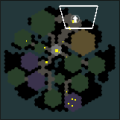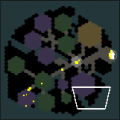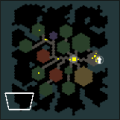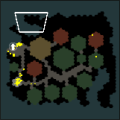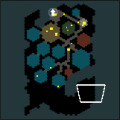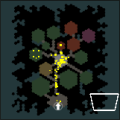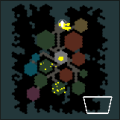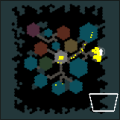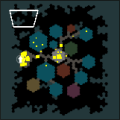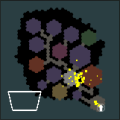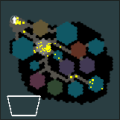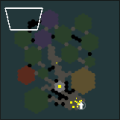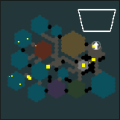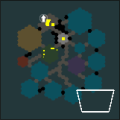Colony: Difference between revisions
mNo edit summary |
No edit summary |
||
| Line 113: | Line 113: | ||
*Matabele ants start with some worker brood tiles and soldier brood tiles. | *Matabele ants start with some worker brood tiles and soldier brood tiles. | ||
*Termites start with a 19-tiled queen chamber, some lignocellulose storage | *Termites start with a 19-tiled queen chamber, some lignocellulose storage, some fungus storage and major worker brood tiles. | ||
Non-player colonies usually work on 2 chambers at once. They upgrade storage and soldiers first and only upgrade workers after everything else has been finished. | Non-player colonies usually work on 2 chambers at once. They upgrade storage and soldiers first and only upgrade workers after everything else has been finished. | ||
| Line 145: | Line 145: | ||
'''Leafcutter ants''': | '''Leafcutter ants''': | ||
<gallery> | <gallery> | ||
| Line 153: | Line 151: | ||
File:Leafcutter Balanced.png|Balanced | File:Leafcutter Balanced.png|Balanced | ||
File:Leafcutter Aggressive.png|Aggressive | File:Leafcutter Aggressive.png|Aggressive | ||
</gallery> | |||
'''Termites''': | |||
<gallery> | |||
File:Termite Docile.png|Docile | |||
File:Termite Timid.png|Timid | |||
File:Termite Balanced.png|Balanced/ Aggressive | |||
</gallery> | </gallery> | ||
Revision as of 21:17, 22 June 2024
This page shows the mechanics of colonies.
Mechanics
You can play with 9 different colonies in the entire game. If you choose to play with wood ants, leafcutter ants, fire ants or Matabele ants, you must pick either of the 2 variants.
You can only control a single colony in any levels or custom games. Non-player colonies can use the same mechanics as you can but are controlled by the game. Every colony must be assigned to a number, a color and an underground area.
Non-player colonies and other enemies are always hostile to eachother.
The respective colony is defeated when its queen is dead. Tiles are deleted every 0.5 second and return 66% of the cost. Refunds are modified to reward the victors: larvae, leaves, termites or lignocellulose.
Colonies aren't affected by powescaling.
Level
Behaviors
Non-player colonies in story levels and extra levels are designed to mimic their real-life counterparts. Nanitic workers are always kept inside to do nest jobs.
Non-player clonies check the surface for food and move gathering groups there.
- Old system: Non-player colonies can only check predetermined locations. Gathering groups move to the most recently chosen locations if they can't find any food.
- New system: Non-player colonies can constantly and thoroughly scan their territories for food or danger and move gathering groups accordingly. Gathering groups remain inside if they can't find any food.
Non-player colonies attack any enemies on the way when they are gathering food. They can disable attacking and retreat inside after they have taken enough casualties.
Non-player colonies can control up to 2 gathering groups and 2 attacking groups.
- Polymorphic species: Gathering groups consist of workers and small soldiers. Attacking groups only consist of large soldiers. They are kept around the queen and are only deployed to protect gathering groups or to invade enemy nests.
- Non-popymorphic species: Gathering groups consist of workers and soldiers. Attacking groups only consist of soldiers. They are only split from other gathering groups to invade enemy nests.
Actual players are more decisive and responsive so non-player colonies always need headstart and cheat to stay threatening. You can only encounter free food cheat in story levels and extra levels.
Nest buidling
Non-player colonies have predetermined nest designs. They can decide building order on their own. They can only build hexagon chambers and can't build highway.
Appearances
You can encounter non-player colonies in:
Custom game mode
Settings
You can play with or without other colonies in custom games. You must choose a color and a team for each colony before you start a custom game. You can only have up to 4 colonies and 4 teams in a single custom game.
You can control temperament of non-player colonies: Docile, Timid, Balanced and Aggressive. It affects their aggressiveness and unit composition.
You can control cheat frequency of non-player colonies: None, Headstart, Underhanded, Cheater, Crooked and Corrupt. They gain free food over time and can spawn units without requiring food or workers. Cheat is automatically disabled when nest invasion is happening.
You can also control how quickly non-player colonies make decision.
You can control whether colonies can enter other nests.
Non-player colonies aren't affected by upkeep and randomized caverns.
Behaviors
Non-player colonies will keep everyone outside to gather food. Nanitic workers only move inside to finish the assigned nest jobs when storage is full and will stay inside permanently after you have played for 30 minutes.
Non-player colonies can only control up to 3 pheromone groups. They can be tasked with either gathering food, gathering aphids or attacking enemy colonies. Non-player colonies can flexibly disable and enable gathering or attacking depending on the current task.
Gathering groups are kept inside if they can't find any food.
Non-player colonies will choose an enemy colony, which is the weakest in biomass, as the main target after they have gathered enough food. They will retreat and gather food after they have taken enough casualties.
- Docile colonies avoid intentional conflicts and stay in their territories.
- Timid colonies harass the target by following its most recently placed pheromone markers early game and only invade its nest late game.
- Aggressive colonies immediately and constantly invade the targeted nest.
Non-player colonies can't respond to nest invasion. They can't actively hunt uber creatures or titans either.
Nest building
Non-player colonies start with the same predug nest and some resources. Some species will have headstart to help them catch up with omnivorous ant species.
- Leafcutter ants start with a 19-tiled queen chamber, some leaf storage, some refuse storage and some minor brood tiles.
- Matabele ants start with some worker brood tiles and soldier brood tiles.
- Termites start with a 19-tiled queen chamber, some lignocellulose storage, some fungus storage and major worker brood tiles.
Non-player colonies usually work on 2 chambers at once. They upgrade storage and soldiers first and only upgrade workers after everything else has been finished.
Unit composition is chosen depending on species and temperament. Docile colonies use mostly workers. Balanced and aggressive colonies use mostly large soldiers. Timid colonies strike a balance between workers, small soldiers and large soldiers.
Black ants/ Little black ants/ Fire ants:
Wood ants:
Big-headed ants:
Leafcutter ants:
Termites:
Gene-thief ants:
Gene-thief ant units are divided into 3 groups: workers, small soldiers and large soldiers. Large soldiers only include leafcutter ant majors and army ant majors. Unit composition is chosen depending on which unit group they have access to.
If they have access to multiple unit options in the same group, they will choose randomly among the available options and try to build a chamber for each option.
If large soldiers aren't available, they are replaced with small soldiers. If small soldiers aren't available, they are replaced with workers.
Trivia
(none)
 Hooded Horse Wikis
Hooded Horse Wikis